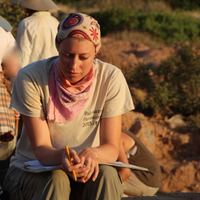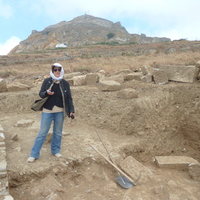Articles by Jérémy Lamaze

Manolis I. Stefanakis, Georgios Mavroudis, Fani K. Seroglou, and Maria Achiola (Eds), Religion and Cult in the Dodecanese during the First Millennium BC (Archeopress Publishing Ltd), Oxford, 2023
This contribution reconsiders the Archaic suburban shrine, called ‘La chapelle’, at Vroulia (Rhod... more This contribution reconsiders the Archaic suburban shrine, called ‘La chapelle’, at Vroulia (Rhodes), excavated at the beginning of the 20th century. More specifically, it aims at replacing the building into the typology of Aegean and Eastern Mediterranean ‘hearth temples’, and also to investigate the influences throughout the regions in connection with the island of Rhodes. The Archaic settlement of Vroulia is one of the most important early settlements in the Aegean, dating from the 7th – 6th century BC. The site was excavated by the Danish Αrchaeological Εxpedition in Rhodes in the early 20th century under the supervision of K.F. Kinch. On the southeast foot of Vroulia hill, outside the settlement, Kinch investigated the remains of a small archaic temple (‘La chapelle’), belonging to the early 7th century BC, and therefore considered to be one of the earliest temple-buildings known from the Archaic period. The typology of this ‘in antae’ building with a central (hearth?) altar, fire-pit, and a wall bench, as well as the artefacts associated, have been interpreted in terms of influences with Crete. The multiplicity of new archaeological contexts since its discovery allows us today to re-examine this strategic Rhodian settlement and to better understand this particular, and still quite unparalleled, building.
Board Game Studies Journal, 2022
In the sanctuary of Kition-Kathari (Cyprus), a building with benches, identified as a temple ("Te... more In the sanctuary of Kition-Kathari (Cyprus), a building with benches, identified as a temple ("Temple 4"), is characterized in its centre by a hearth pit next to a trapezoidal stone construction, constituting "Altar E". The platform's surface comprises a series of little cup-holes. Once labelled "table of offerings", it has recently been interpreted as a gaming table. Besides clay gaming stones, this area has yielded knucklebones as well as several deposits of incised scapulae linked with divination practices. This Cypriot context gives us the opportunity to explore and also to put in light the influences and interactions between different regions of the Eastern Mediterranean at the turn of the 1st millennium BC.

Revue archéologique , 2019
A temple too good to be true? The so‐called ‘Temple A’ of Prinias reconsidered
In 1907, the ex... more A temple too good to be true? The so‐called ‘Temple A’ of Prinias reconsidered
In 1907, the excavations conducted by Luigi Pernier at Prinias in Crete brought to light two buildings, laid out side by side and characterized by a central hearth. These buildings were immediately identified as temples. But, although this function has been dismissed since then for ‘Temple B’, ‘Temple A’ is still considered as one of the earliest examples of temple architectural sculpture in the Greek world, despite falling outside the Greek architec‐ tural orders. Recent studies at Prinias show that a critical re‐examination of this issue is sorely needed. This paper goes back over the criteria for the identification of a Greek temple, even more complex in the Cretan context, before reconsidering the building in its archaeological context. This study aims to cross‐examine the architectural, arte‐ factual, iconographic and osteological data with a view to proposing a new identification for this edifice.

[English below]
À la fin de l’âge du Bronze, tant à Chypre qu’au Levant sud, on observe l’appari... more [English below]
À la fin de l’âge du Bronze, tant à Chypre qu’au Levant sud, on observe l’apparition de pièces à foyers dans des édifices à caractère public ou à fonction cultuelle. Pourtant, ce genre d’aménagement semble étranger tant à la tradition architecturale chypriote que syro-palestinienne. Auparavant, que ce soit dans les habitats ou bien dans les temples, il semble que les foyers ne faisaient pas partie des aménagements des pièces – tout au plus les trouve-t-on à l’extérieur des constructions, en général dans des cours, en particulier dans les palais cananéens. Les spécialistes ont mis en relation cette nouveauté avec une série d’innovations technologiques, traditionnellement interprétées comme égéennes, décelables au travers de la culture matérielle (constructions en pierre de taille, céramique mycénienne IIIC:1b, baignoires, etc.).
At the end of the Bronze Age, both in Cyprus and Southern Levant, we observe the appearance of hearth rooms in ceremonial buildings of public or religious nature. Nevertheless, that kind of installation seems foreign both to the Cypriot and the Syro-Palestinian architectural tradition. Previously, whether it was in settlements or in temples, it seems that hearths were not set up in rooms – at best, they are found outside of the constructions, generally in courtyards (particularly in the Canaanite palaces). Specialists have connected this novelty with a series of technological innovations, traditionally interpreted as Aegean and detectable through the material culture (buildings in ashlar masonry, Mycenaean IIIC:1b pottery, bathtubs, etc.).
Spazio sacro e potere politico in Grecia e nel Vicino Oriente, 2014
I diritti di traduzione, di memorizzazione elettronica, di riproduzione e di adattamento anche pa... more I diritti di traduzione, di memorizzazione elettronica, di riproduzione e di adattamento anche parziale, con qualsiasi mezzo, sono riservati per tutti i Paesi.
Anno di fondazione: 2011 D. Lefèvre-Novaro, A. Pautasso, S. Rizza, J. Lamaze, Dreros e Priniàs: n... more Anno di fondazione: 2011 D. Lefèvre-Novaro, A. Pautasso, S. Rizza, J. Lamaze, Dreros e Priniàs: nuovi dati e prospettive di ricerca sulla polis a Creta

Πεπραγμένα ΙΑ᾽Διεθνούς Κρητολογικού Συνεδρίου (Ρέθυμνο, 21-27 Οκτωβρίου 2011), Τόμος Α2.1, 2018
Several Aegean sites, like those of Smari and Prinias in Crete, reveal architectural evidence for... more Several Aegean sites, like those of Smari and Prinias in Crete, reveal architectural evidence for the presence of an élite through the Greek Dark Ages (c. 1150 - 800 BC). Additionally, among these examples, a specific type of building called “hearth temples” is particularly well represented. The presence of the hearth temple suggests that, long ago, the place of the altar was not in front of the temple as in the well-known practice of the thysia, but rather within it. Indeed, these fireplaces, which are always discovered in a central position within these buildings, are far from being limited to domestic use, such as cooking. Instead, these structures, associated with other elements, such as particular ceramic forms, votives, or tools, offer us the possibility to understand a truly ancient ritual use of the kitchen – that of sacrifice, most probably practiced by the local ruler himself. Thus, commensal dining is also attested in these buildings that share some characteristics with later prytaneion containing the holy fire of Hestia, goddess of the hearth. In this respect, this study will touch upon an origin of Greek sacrifice of sacerdotal nature, but one nevertheless restricted to specific demographic groups, such as those who participated in heroic feats, war, or cynegetic activities as well as horsemen.

During the Bronze Age the central unit of the Mycenaean palace was equipped with a monumental hea... more During the Bronze Age the central unit of the Mycenaean palace was equipped with a monumental hearth, centrally situated and generally surrounded by four columns. In the EIA, appeared among the first temples of the Aegean a type of building known as “ hearth temple ”. Both of these halls, which may, on particular occasions, have involved ritual dining, necessitated smoke evacuation supplies. What do we know about those equipements and, in particular, what do we know about chimneys prior to the Classical period? The litterary and iconographic evidence, as well as recent artifact finds, lead us today to a better understanding of this architectural development. This, in turn, has important implications for the restoration of those buildings in elevation.
À l’Âge du Bronze la salle principale du palais mycénien était pourvue d’un vaste foyer, en position centrale, le plus souvent encadré par quatre colonnes. Dans le monde égéen, parmi les premiers temples du début de l’Âge du Fer s’épanouit un type de construction connu sous le nom de « temple à foyer central ». Ces pièces qui pouvaient être le théâtre de banquets cérémoniels et / ou rituels nécessitaient des systèmes d’évacuation des fumées. Que connaît-on de ces dispositifs et, en particulier, des cheminées avant la période classique ? Les témoignages littéraires, iconographiques, ainsi que les données artéfactuelles récentes permettent aujourd’hui de mieux appréhender ce type d’aménagement architectural, ce qui, en outre, a des répercussions majeures sur la manière de restituer ces édifices en élévation.
BOOK by Jérémy Lamaze

Ritual and commensal practices in the Mediterranean Iron Age from the Aegean World to the Iberian Peninsula, 2021
From basic needs, such as lighting, heating or cooking, to symbolic or ritual engagement, hearths... more From basic needs, such as lighting, heating or cooking, to symbolic or ritual engagement, hearths in indoor contexts serve as a focal point. This is especially evident, both spatially and architecturally, in structures with central hearths. With any gathering around a hearth, the types of social groups involved need to be determined and their interactions clearly assessed in each specific case. Beyond clearly domestic contexts, many rooms or buildings have been deemed religious or cultic places often based solely on the presence of a hearth, despite other possible interpretations. This volume appraises and contextualises diversity in practice centering on the hearth in the Aegean and, more widely, in areas of the Western Mediterranean closely connected to Greek civilization, notably through its colonies, revealing surprising similarities but also local adaptations. In the West, the use of the hearth often has a unique character arising from local adaptations born of indigenous practices. The combined approach presented here, detailing technical aspects of the hearths themselves, their architectural settings and any associated artefacts or furnishings, affords a rich spectrum for cross-cultural analysis between these Mediterranean regions.
BOOK CHAPTER by Jérémy Lamaze
Around the Hearth, 2021
Behind closed doors? Greek sacrificial rituals performed inside buildings in the Early Iron Age a... more Behind closed doors? Greek sacrificial rituals performed inside buildings in the Early Iron Age and the Archaic period 13 Evangelia Simantoni-Bournia Hearth-temples in the sanctuary of Hyria on Naxos 40 Karine Rivière La cuisine ou l'autel ? Foyers, cultes et commensalités dans la Grèce de l'Âge du fer (x e-viii e s. av. J.-C.) 71 Jérémy Lamaze De la difficulté d'interprétation des pièces à foyer dans le monde grec au début de l'Âge du fer : un état des lieux 84
PhD Thesis by Jérémy Lamaze

The aim of this study is to investigate a series of edifices found in the Aegean, on Cyprus and i... more The aim of this study is to investigate a series of edifices found in the Aegean, on Cyprus and in the East dating from the end of the Bronze Age through to the Archaic Period and collectively referred to as ‘Hearth Temples’. The study is centred on an
evaluation of the architecture and artefacts relating to a type of building often thought to have constituted elite housing from the so- called Dark Ages. The presence of a hearth/altar in the centre of these constructions, which served as a religious focal point, suggests that they played a significant role in the genesis of the Greek temple. Within the timeframe of this study, these buildings display banquet halls designed for elite rituals and in which the main activity was the practice of animal sacrifice. These rooms, often serving multiple functions, gave rise to the first ‘citizen temples’ within the context of Cretan poleis. The relevant testimonia are listed here in an exhaustive catalogue that also takes into account relevant object finds. The first part of the study concerns itself with a re- evaluation of the nomenclature associated with these monuments, before analysing the antecedents to this type of architecture at the end of the Bronze Age and for each of the geographical regions in question. The following chapter questions the symbolic dimension of fire in these civilisations, incarnated in Greek antiquity by Hestia, the goddess of the hearth, as well as by her role in political institutions (andreia, prytaneis etc.). In the next chapter, the mutual influence these different Mediterranean regions had on each other is explored, both in terms of material culture (exotica, architectural influence) and in terms of religious beliefs (religious syncretism). The final chapter brings together all of the findings and summarizes the architectural problems associated with these buildings, for which a series of tables is also included.
Talks by Jérémy Lamaze
Autour du foyer : pratiques rituelles et modes de commensalité dans la Méditerranée de l'Âge du fer, de l'Égée à la péninsule ibérique, 2019
Université Paris Nanterre, 7 juin 2019, bâtiment W - Max Weber, salle des conférences

In the sanctuary of Kition-Kathari (Cyprus), a building with benches, identified as a temple (« T... more In the sanctuary of Kition-Kathari (Cyprus), a building with benches, identified as a temple (« Temple 4 »), is characterized in its centre by a hearth pit next to a trapezoidal stone construction, constituting « Altar E ». The platform’s surface comprises a series of little holes (cupules). First lamely labelled « table of offerings », it has recently been interpreted as a gaming table. Besides clay gaming stones, this area has yielded knucklebones as well as a deposit of incised scapulae linked with divination practices. It is noteworthy that the chronology of this structure seems to be related with the coming of “Cretan refugees” on the island of Cyprus. This element may not be anecdotic since in Crete the existence of kernoi or “pierres à cupules” (game boards or offerings tables) is particularly well documented and has a long tradition dating back to the Bronze Age. Furthermore, the presence of incised scapulae in association with hearths finds clear parallels in the near Levant. This Cypriot context will give us the opportunity to explore and also to put in light the influences and interactions between those regions of the Eastern Mediterranean at the turn of the 1st millennium B.C.

Les Grecs de l’Antiquité n’ont pas de mot pour désigner ce qu’à la suite de J.-P. Vernant les che... more Les Grecs de l’Antiquité n’ont pas de mot pour désigner ce qu’à la suite de J.-P. Vernant les chercheurs spécialistes nomment « le sacrifice sanglant de consommation alimentaire ». Certains termes font effectivement référence à cette cérémonie, au cours de laquelle la mise à mort d’une victime animale est suivie du partage des parts comestibles et non comestibles entre les hommes et les dieux, mais ces termes peuvent tous également désigner d’autres cérémonies, qui n’impliquent pas le partage de la victime, ou qui n’impliquent même aucune mise à mort. Inadéquate parce qu’elle ne renvoie pas nécessairement à une catégorie que les Anciens ont tenu à distinguer à travers leur lexique, l’expression « sacrifice sanglant de consommation alimentaire » l’est aussi parce que penser cette cérémonie comme étant un « sacrifice » invite à donner une importance sans doute exagérée à la mise à mort de la victime, et au prétendu sentiment de culpabilité qu’elle implique. Pour les anciens Grecs, la mise à mort peut avoir été un moyen permettant d’établir une communication avec des puissances supérieures, mais quand l’animal abattu devait être partagé, ce n’était que le pivot autour duquel s’organisaient les actes de consécration, consécrations de prémices d’une part, et des parts réservées aux dieux de l’autre. Ces séquences rituelles ne se distinguent pas des autres parce qu’elles impliquent une mise à mort, mais parce qu’elles sont de loin les plus complexes. C’est dans leur complexité même que réside leur signification, et l’apport majeur de l’anthropologie structurale est d’avoir montré comment les éléments composant ces séquences pouvaient être compris comme autant de parties d’un discours révélant leur signification profonde. Cela étant, les sources textuelles, iconographiques, et archéologiques suggèrent qu’avant l’époque classique l’ordonnance d’une séquence comprenant la mise à mort et le partage d’une victime n’est pas fixe, et le choix des éléments composant la séquence devait être fonction du contexte et de l’implication personnelle des protagonistes. Il est donc moins pertinent de tenter de dégager une signification, une « théorie générale du sacrifice », que de montrer dans quelles conditions les Grecs ont pu chercher à présenter l’abattage d’une victime animale comme un sacrifice.

Si, d’une manière générale, dans les sanctuaires grecs la présence du temple n’est pas indispensa... more Si, d’une manière générale, dans les sanctuaires grecs la présence du temple n’est pas indispensable, celle d’un autel est primordiale pour l’accomplissement des rites. Or, plusieurs édifices crétois d’époque géométrique et orientalisante (c. VIIIe-VIIe s. av. J.-C.), reconnus comme des temples, sont à l’évidence dépourvus de ce genre d’aménagement. En réponse à cette spécificité, les spécialistes ont avancé l’idée que les foyers découverts à l’intérieur de ces édifices remplissaient une fonction similaire à celle des autels en plein air qui caractérisent les sanctuaires grecs et destinés au sacrifice animal. À partir des contextes de Prinias (pseudo « temple A »), de Dréros (Delphinios) et de Kommos (« temple B »), que nous comparerons à une série de monuments crétois, nous tenterons de replacer ces exemples parmi d’autres temples contemporains du monde grec. Nous verrons que les édifices cultuels crétois du Premier âge du fer n’en sont pas à une spécificité près, eu égard au reste de la Grèce : point de péristasis, ni de colonnade, avant l’époque romaine sur l’île, par exemple. Trop souvent laissés de côté, les analyses ostéologiques, ainsi que le mobilier associé, seront à la base de notre propos pour tenter de résoudre cette apparente contradiction, d’autant que l’absence d’un réel dépôt votif et/ou d’un symbole de culte – éléments qui constituent les critères d’identification d’un temple – permet légitimement de remettre en cause l’hypothèse cultuelle pour nombre de ces contextes.
CONFERENCE ORGANIZATION by Jérémy Lamaze











Uploads
Articles by Jérémy Lamaze
In 1907, the excavations conducted by Luigi Pernier at Prinias in Crete brought to light two buildings, laid out side by side and characterized by a central hearth. These buildings were immediately identified as temples. But, although this function has been dismissed since then for ‘Temple B’, ‘Temple A’ is still considered as one of the earliest examples of temple architectural sculpture in the Greek world, despite falling outside the Greek architec‐ tural orders. Recent studies at Prinias show that a critical re‐examination of this issue is sorely needed. This paper goes back over the criteria for the identification of a Greek temple, even more complex in the Cretan context, before reconsidering the building in its archaeological context. This study aims to cross‐examine the architectural, arte‐ factual, iconographic and osteological data with a view to proposing a new identification for this edifice.
À la fin de l’âge du Bronze, tant à Chypre qu’au Levant sud, on observe l’apparition de pièces à foyers dans des édifices à caractère public ou à fonction cultuelle. Pourtant, ce genre d’aménagement semble étranger tant à la tradition architecturale chypriote que syro-palestinienne. Auparavant, que ce soit dans les habitats ou bien dans les temples, il semble que les foyers ne faisaient pas partie des aménagements des pièces – tout au plus les trouve-t-on à l’extérieur des constructions, en général dans des cours, en particulier dans les palais cananéens. Les spécialistes ont mis en relation cette nouveauté avec une série d’innovations technologiques, traditionnellement interprétées comme égéennes, décelables au travers de la culture matérielle (constructions en pierre de taille, céramique mycénienne IIIC:1b, baignoires, etc.).
At the end of the Bronze Age, both in Cyprus and Southern Levant, we observe the appearance of hearth rooms in ceremonial buildings of public or religious nature. Nevertheless, that kind of installation seems foreign both to the Cypriot and the Syro-Palestinian architectural tradition. Previously, whether it was in settlements or in temples, it seems that hearths were not set up in rooms – at best, they are found outside of the constructions, generally in courtyards (particularly in the Canaanite palaces). Specialists have connected this novelty with a series of technological innovations, traditionally interpreted as Aegean and detectable through the material culture (buildings in ashlar masonry, Mycenaean IIIC:1b pottery, bathtubs, etc.).
À l’Âge du Bronze la salle principale du palais mycénien était pourvue d’un vaste foyer, en position centrale, le plus souvent encadré par quatre colonnes. Dans le monde égéen, parmi les premiers temples du début de l’Âge du Fer s’épanouit un type de construction connu sous le nom de « temple à foyer central ». Ces pièces qui pouvaient être le théâtre de banquets cérémoniels et / ou rituels nécessitaient des systèmes d’évacuation des fumées. Que connaît-on de ces dispositifs et, en particulier, des cheminées avant la période classique ? Les témoignages littéraires, iconographiques, ainsi que les données artéfactuelles récentes permettent aujourd’hui de mieux appréhender ce type d’aménagement architectural, ce qui, en outre, a des répercussions majeures sur la manière de restituer ces édifices en élévation.
BOOK by Jérémy Lamaze
BOOK CHAPTER by Jérémy Lamaze
PhD Thesis by Jérémy Lamaze
evaluation of the architecture and artefacts relating to a type of building often thought to have constituted elite housing from the so- called Dark Ages. The presence of a hearth/altar in the centre of these constructions, which served as a religious focal point, suggests that they played a significant role in the genesis of the Greek temple. Within the timeframe of this study, these buildings display banquet halls designed for elite rituals and in which the main activity was the practice of animal sacrifice. These rooms, often serving multiple functions, gave rise to the first ‘citizen temples’ within the context of Cretan poleis. The relevant testimonia are listed here in an exhaustive catalogue that also takes into account relevant object finds. The first part of the study concerns itself with a re- evaluation of the nomenclature associated with these monuments, before analysing the antecedents to this type of architecture at the end of the Bronze Age and for each of the geographical regions in question. The following chapter questions the symbolic dimension of fire in these civilisations, incarnated in Greek antiquity by Hestia, the goddess of the hearth, as well as by her role in political institutions (andreia, prytaneis etc.). In the next chapter, the mutual influence these different Mediterranean regions had on each other is explored, both in terms of material culture (exotica, architectural influence) and in terms of religious beliefs (religious syncretism). The final chapter brings together all of the findings and summarizes the architectural problems associated with these buildings, for which a series of tables is also included.
Talks by Jérémy Lamaze
CONFERENCE ORGANIZATION by Jérémy Lamaze
In 1907, the excavations conducted by Luigi Pernier at Prinias in Crete brought to light two buildings, laid out side by side and characterized by a central hearth. These buildings were immediately identified as temples. But, although this function has been dismissed since then for ‘Temple B’, ‘Temple A’ is still considered as one of the earliest examples of temple architectural sculpture in the Greek world, despite falling outside the Greek architec‐ tural orders. Recent studies at Prinias show that a critical re‐examination of this issue is sorely needed. This paper goes back over the criteria for the identification of a Greek temple, even more complex in the Cretan context, before reconsidering the building in its archaeological context. This study aims to cross‐examine the architectural, arte‐ factual, iconographic and osteological data with a view to proposing a new identification for this edifice.
À la fin de l’âge du Bronze, tant à Chypre qu’au Levant sud, on observe l’apparition de pièces à foyers dans des édifices à caractère public ou à fonction cultuelle. Pourtant, ce genre d’aménagement semble étranger tant à la tradition architecturale chypriote que syro-palestinienne. Auparavant, que ce soit dans les habitats ou bien dans les temples, il semble que les foyers ne faisaient pas partie des aménagements des pièces – tout au plus les trouve-t-on à l’extérieur des constructions, en général dans des cours, en particulier dans les palais cananéens. Les spécialistes ont mis en relation cette nouveauté avec une série d’innovations technologiques, traditionnellement interprétées comme égéennes, décelables au travers de la culture matérielle (constructions en pierre de taille, céramique mycénienne IIIC:1b, baignoires, etc.).
At the end of the Bronze Age, both in Cyprus and Southern Levant, we observe the appearance of hearth rooms in ceremonial buildings of public or religious nature. Nevertheless, that kind of installation seems foreign both to the Cypriot and the Syro-Palestinian architectural tradition. Previously, whether it was in settlements or in temples, it seems that hearths were not set up in rooms – at best, they are found outside of the constructions, generally in courtyards (particularly in the Canaanite palaces). Specialists have connected this novelty with a series of technological innovations, traditionally interpreted as Aegean and detectable through the material culture (buildings in ashlar masonry, Mycenaean IIIC:1b pottery, bathtubs, etc.).
À l’Âge du Bronze la salle principale du palais mycénien était pourvue d’un vaste foyer, en position centrale, le plus souvent encadré par quatre colonnes. Dans le monde égéen, parmi les premiers temples du début de l’Âge du Fer s’épanouit un type de construction connu sous le nom de « temple à foyer central ». Ces pièces qui pouvaient être le théâtre de banquets cérémoniels et / ou rituels nécessitaient des systèmes d’évacuation des fumées. Que connaît-on de ces dispositifs et, en particulier, des cheminées avant la période classique ? Les témoignages littéraires, iconographiques, ainsi que les données artéfactuelles récentes permettent aujourd’hui de mieux appréhender ce type d’aménagement architectural, ce qui, en outre, a des répercussions majeures sur la manière de restituer ces édifices en élévation.
evaluation of the architecture and artefacts relating to a type of building often thought to have constituted elite housing from the so- called Dark Ages. The presence of a hearth/altar in the centre of these constructions, which served as a religious focal point, suggests that they played a significant role in the genesis of the Greek temple. Within the timeframe of this study, these buildings display banquet halls designed for elite rituals and in which the main activity was the practice of animal sacrifice. These rooms, often serving multiple functions, gave rise to the first ‘citizen temples’ within the context of Cretan poleis. The relevant testimonia are listed here in an exhaustive catalogue that also takes into account relevant object finds. The first part of the study concerns itself with a re- evaluation of the nomenclature associated with these monuments, before analysing the antecedents to this type of architecture at the end of the Bronze Age and for each of the geographical regions in question. The following chapter questions the symbolic dimension of fire in these civilisations, incarnated in Greek antiquity by Hestia, the goddess of the hearth, as well as by her role in political institutions (andreia, prytaneis etc.). In the next chapter, the mutual influence these different Mediterranean regions had on each other is explored, both in terms of material culture (exotica, architectural influence) and in terms of religious beliefs (religious syncretism). The final chapter brings together all of the findings and summarizes the architectural problems associated with these buildings, for which a series of tables is also included.
Shared Identities, through contact with the other: techniques, images and styles (ArchMGr & ArchMGr-Si, UMR 7041-ArScAn).
Projet collectif du Laboratoire ArScAn (2019-2024) : Identités partagées, au contact de l'autre : techniques, images et styles.
Porteurs : ArchMGr-Si (Philippe Jockey) & ArchMGr (Francis Prost).